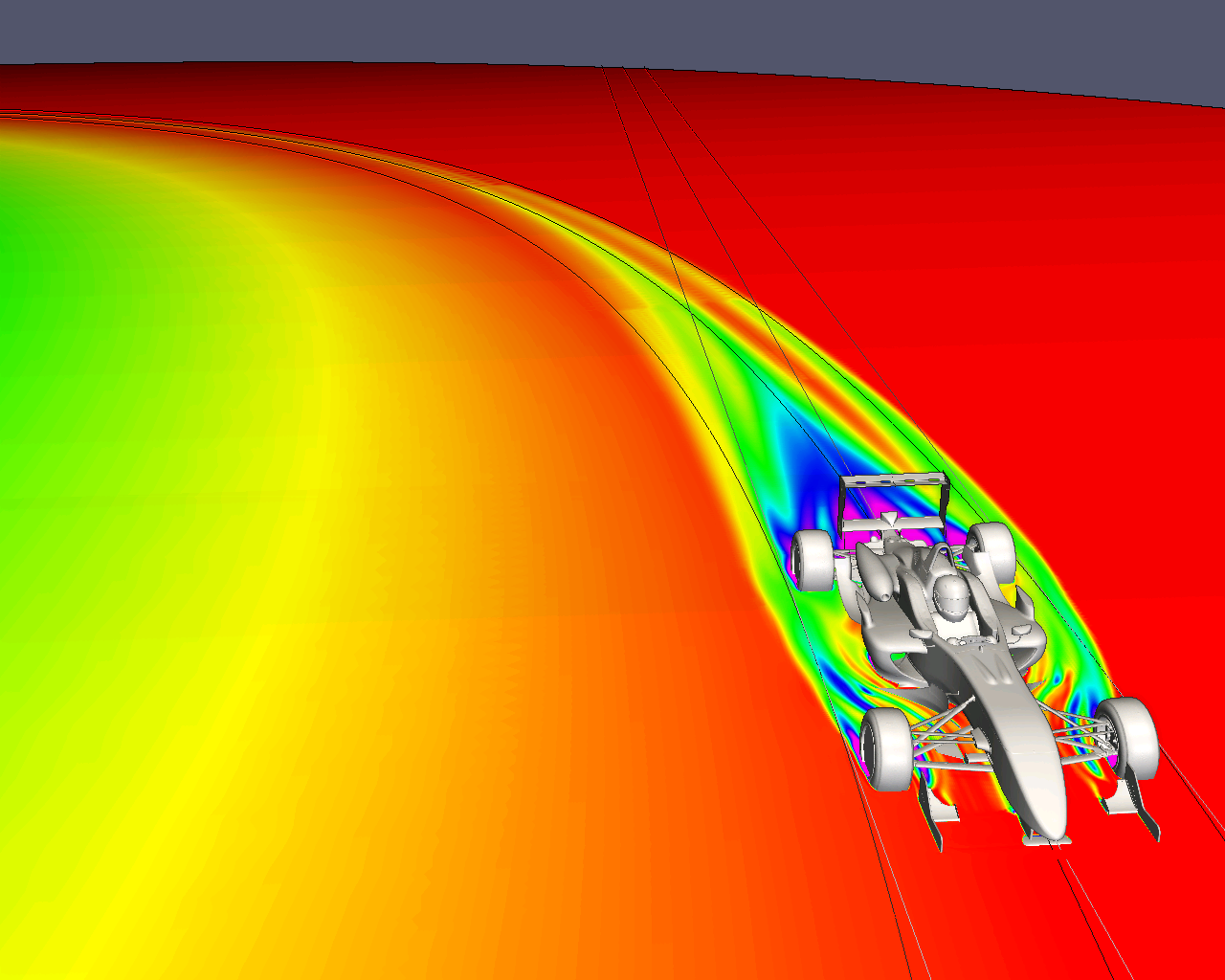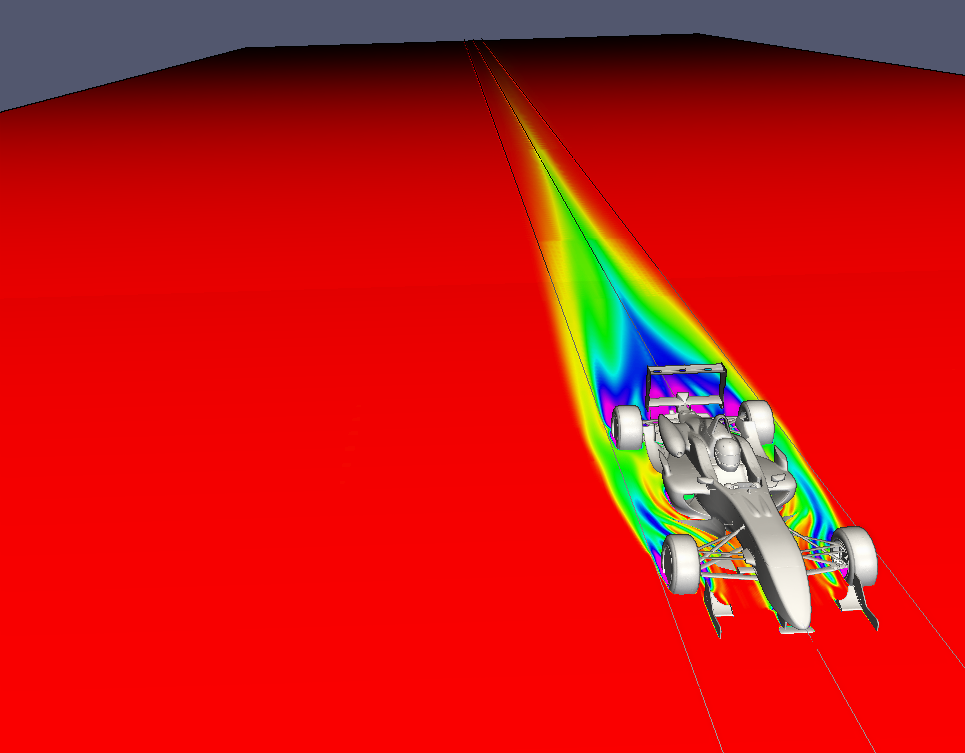CFD versus tunnel versus track – part 2
As we saw in part 1 of this discussion, Formula One aerodynamics is driven by several toolsets – track testing, full scale tunnel, model scale tunnel testing and CFD. In part 1 we looked at the list on the left of the mind map below, so in this part I want to move on from there and work down the list on the right.
Rate of change of car state: This is best illustrated by the braking event at the end of a straight. Here the car changes from a low ride height (high downforce pushing the car into the track at high speed) to a pitched high rear/low front as the brakes are applied. This change in attitude is very quick and happens on almost the same time scale it takes for the air to travel from the front of the car to the back. It is a true transient bit of aerodynamics that can’t be reliably modelled as a series of steady-state car attitudes during the braking phase.
The effect of ignoring this physics is that well behaved diffusers (designed in tunnel and CFD) may start to stall at the track as the brakes are applied; also they may not re-attach that quickly either. This is one example of rate of change of car attitude, but there’s also rate of change of yaw, roll and steer.
The options for measuring this effect are fairly limited. CFD is only starting to be able to model this transient, moving body, type of simulation. Tunnels have motion systems and can replicate the braking pitch change but the challenge comes in separating out the aero forces during the pitch change from the inertial forces needed to pitch the car itself – very tricky indeed, and also very important as diffuser design gets more complex and closer to the limit of transient stall effects.
Exhaust flow rate: Recent years have seen exhaust flow playing an important part in Formula One aero, and these days the effects of exhaust gases are included routinely in tunnel and CFD testing. CFD probably has the upper hand here as it can model hot gases at the right flow rate, whereas most tunnel tests are limited to cold flow and reduced flow rates. Similar to the rate of change of car state described above, the exhaust gas flow can change very quickly, and true transient analysis of rapidly changing exhaust flow rates could become important too.
Airbox intake flow: As for exhaust flows this is routinely included in CFD and tunnel tests. It is simpler than exhaust flows though as there is no hot flow. Scale tunnels can often be limited in airbox intake work because the mounting strut for the model tends to sit in front of the air intake. Again, transient effects of rapidly changing intake flows could become important, but this is unlikely.
Corner curvature: When the car is cornering, the air flowing over it isn’t travelling straight but in a curve, so the approach angle varies from the front to the back of the car. This effect was until recently considered to be negligible, but teams have realised that it becomes important as we look deeper for more aero gains. CFD was able to simulate curved flow back in 2001, so has had the capability for a long time. Tunnel testing, however, is capable of straight wind only. So to predict true cornering aero forces CFD has a significant advantage here. Most teams are looking at cornering flow; few though are prepared to make a cornering CFD simulation the definitive test before the track – yet.
Rate of change of corner curvature: Continuing with the theme of it not being just about steady flow but the rate of change of flow or attitude, the rate of change of corner curvature will have an influence on aero forces. It’s probably safe to say that none of the teams are looking at dynamic curvature of flow, and it’s likely that the effect is small compared to the dynamic braking event. Eventually a CFD run will perhaps be a dynamic simulation of straight, brake, turn in, corner and exit – throughout which tyre shape, flow curvature, wing deflections and exhaust flows are all dynamically changing. With current CFD tools, such a simulation is difficult but not out of reach.
Wake onset from a leading car: Wake effects have been studied extensively recently with regard to overtaking performance. Rarely are wake effects considered when optimising a car’s aerodynamics; rather, this is done in clean flow. Testing two cars in a wind tunnel is not impossible, and in CFD as well interactions can be studied. Again it’s not important enough to look at routinely, and the DRS button has reduced that importance further.
Atmospheric conditions: In other words, wind and its velocity, direction, boundary layer profile and how all that changes with time. Aerodynamics is often about creating a robust design, something that performs under a range of operating conditions. Making a car well behaved aerodynamically under varying car attitudes is not the same as designing aero to work on a windy day – again, the nasty non-linearity of aerodynamics pops up, where a small change can cause a finely optimised device to switch flow modes and effectively fail.
Some roadcar wind tunnels can create ‘wobbly wind’ though, to simulate transient wind conditions using moving vanes ahead of the car. Formula One tunnels haven’t applied this technique and have focused on steady, clean flow. On the other hand, CFD can easily do some of the elements of transient atmospheric conditions (like boundary layer profile) but some aspects are still challenges. The chances are that the teams aren’t looking at this with CFD or tunnels but are probably thinking about it for their next wind tunnel upgrade or purchase.
Heat rejection from brakes and radiators: As air is heated it expands and so becomes less dense, and if it’s in a duct it will accelerate. Wind tunnel testing rarely sees hot brakes or radiators as these factors are very difficult to implement or control. CFD can solve thermal problems and include the effects, but these tend to be specialist cooling models rather than routinely incorporated into the standard CFD aerodynamic simulation. Most of the time the assumption of cold flow is valid but, as above, at some point it will be important and standard.
So in summary these are the various levels of physical phenomena that contribute to aero forces. Some are routinely included in Formula One tunnels and CFD tools; some are simply missing. The question of validating CFD versus tunnel versus track becomes somewhat academic in contrast to the missing physics from the CFD and tunnel tests. Arguing over a 2% balance difference between CFD and tunnel should be seen in context of what the balance shift would be from straight to curved flow, hot to cold or static to dynamic. The last point to make is that CFD will only ever be a mathematical approximation of real air and turbulence, and although the above may paint an advantage for CFD, its biggest downside is the fake wind.
 Fig. 1 - The wake behind a Formula Three car in straight flow (Courtesy of TotalSim)
Fig. 1 - The wake behind a Formula Three car in straight flow (Courtesy of TotalSim)
 Fig. 2 - The wake behind a Formula Three car in curved or cornering flow. Here the wake can be seen to be following an arc along the path the car would have taken. Notice also that the air has more energy (colours are total pressure) the further away from the centre of the turn you are (Courtesy of TotalSim)
Fig. 2 - The wake behind a Formula Three car in curved or cornering flow. Here the wake can be seen to be following an arc along the path the car would have taken. Notice also that the air has more energy (colours are total pressure) the further away from the centre of the turn you are (Courtesy of TotalSim)
Written by Rob Lewis